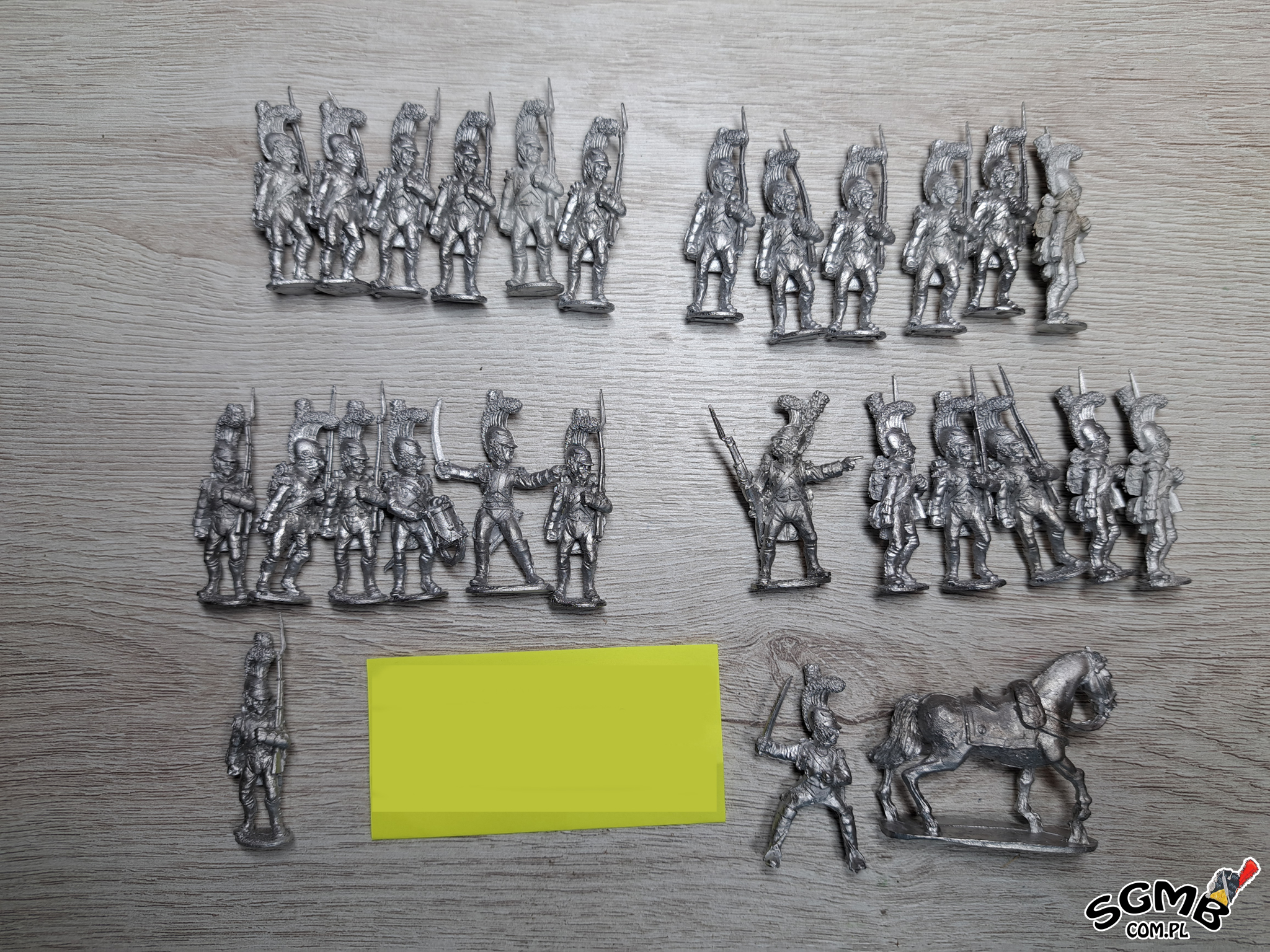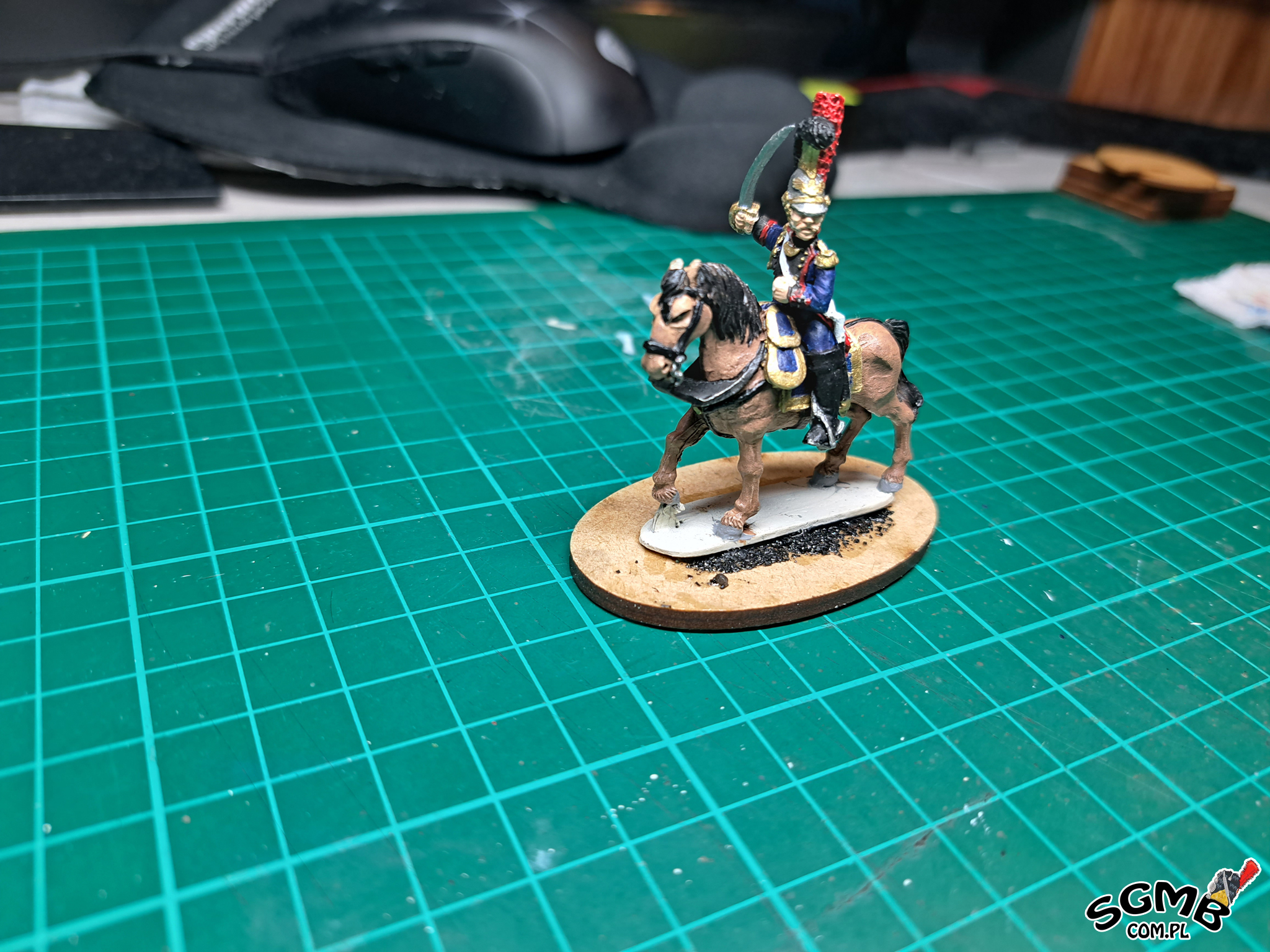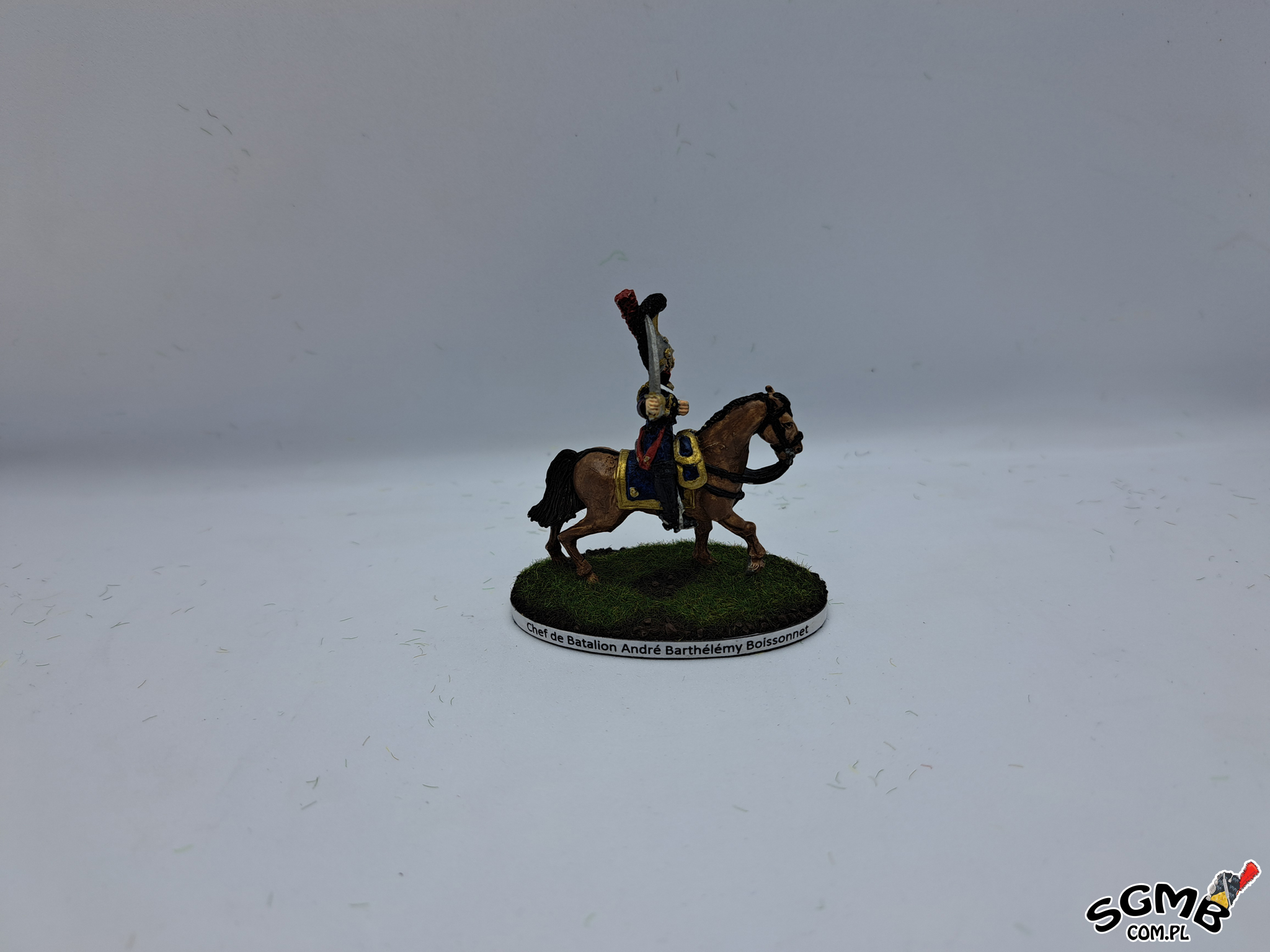[22.12.2023] Wojny Napoleońskie 28mm - Francja [1815]
|
Saperzy Gwardii - Szef Batalionu André Barthélémy Boissonnet.
Szef Batalionu dla Saperów Gwardii. |
Guard Sappers - Battalion Chief André Barthélémy Boissonnet.
Chief of the Battalion for the Guard Sappers. |
Sapeurs de la Garde impériale - Chef de Batalion André Barthélémy Boissonnet [1812]
|
Pochodzący z rodziny notariuszy z Annonay w Ardèche, André Boissonnet wstąpił do wojska w 1792 roku, do wojsk inżynieryjnych.
Podczas oblężenia Tulonu (1793), gdzie był zastępcą inżyniera (od września do grudnia 1793). Następnie Boissonnet uczęszczał do szkół inżynieryjnych w Mézières, a następnie w Metz, które ukończył jako porucznik inżynierii w listopadzie 1794. Następnie służył w armii Sambry i Mozy (1794), Pirenejów Zachodnich (1795) i Włoch (1795-1797), gdzie w marcu 1796 roku został nagrodzony stopniem kapitana. Generał Bonaparte, który został naczelnym dowódcą armii włoskiej, powierzył mu ważną misję pracy przy oblężeniu Mantui (1796-1797). Następnie biorąc udział w niemal wszystkich kampaniach Konsulatu, w listopadzie 1801 roku został zastępcą dyrektora fortyfikacji. Wstępując do Straży Konsularnej w marcu 1803 roku jako dowódca batalionu inżynieryjnego, został wyznaczony na kierownika koszar w stopniu majora. Został mianowany oficerem Legii Honorowej w czerwcu 1804. Gwardia Konsularna stała się Gwardią Cesarską, a on w niej pozostał i przeszedł kampanie Wielkiej Armii w 1805 (Austria), 1806 (Prusy), 1807 (Polska) i 1809 (Niemcy). Znajdując się na czele inżynierów podczas bitew pod Eylau, Heilsberg i Friedland. Zatwierdzony na majora inżynierów Gwardii Cesarskiej w stopniu pułkownika w lutym 1812 roku i w tym charakterze brał udział w kampanii rosyjskiej, był świadkiem bitwy pod Moskwą. Mianowany przez Berthiera szefem sztabu wojsk inżynieryjnych Armii Menu w kwietniu 1813 r., brał udział w kampanii Saksonii (1813 r.) . Legenda głosi, że w bitwie pod Dreznem w 1813 roku Napoleon I, dokonując inspekcji prac inżynieryjnych, zapytał pułkownika Boissonneta o odległość, jaka dzieli ich od miasta. Pułkownik odpowiedział 1200 metrów. Napoleon, uznając szacunki za błędne, wysłał po sekstans. Urządzenie wskazało 1200 metrów. Następnego dnia pułkownik Boissonnet został mianowany generałem brygady i baronem Imperium. Od 1809 r. kawaler cesarstwa, z nadaniem w Westfalii, we wrześniu 1813 r. otrzymał tytuł barona cesarstwa. Po kampanii francuskiej (1814) restauracja francuska zatrzymała Boissonneta w armii, w 1814 nadała mu krzyż Saint-Louis i powierzyła podkierownictwo fortyfikacji Paryża. Po powrocie z wyspy Elba Boissonnet wrócił do inżynierów Gwardii jako major. Po klęsce pod Waterloo i zwolnieniu armii Boissonnet wrócił do domu, ale do służby powrócił w 1816 roku jako dyrektor fortyfikacji Rochefort, a następnie Abbeville. Awansowany do stopnia honorowego marszałka-de-camp w styczniu 1824 roku i w tym samym roku przeszedł na emeryturę. Boissonnet zmarł w 1839 roku i został pochowany w Sézanne (Marna), mieście, którego został burmistrzem. Źródło: https://fr.wikipedia.org/wiki/Andr%C3%A9_Barth%C3%A9l%C3%A9my_Boissonnet |
Coming from a family of notaries from Annonay in the Ardèche, André Boissonnet joined the army in 1792, joining the engineering troops.
During the Siege of Toulon (1793), where he was deputy engineer (from September to December 1793). Boissonnet then attended engineering schools in Mézières and then in Metz, graduating as a lieutenant of engineering in November 1794. He then served in the armies of Sambre and Meuse (1794), Western Pyrenees (1795) and Italy (1795-1797), where in March 1796 he was awarded the rank of captain. General Bonaparte, who became commander-in-chief of the Italian army, entrusted him with the important mission of working at the siege of Mantua (1796-1797). Then, taking part in almost all of the Consulate's campaigns, in November 1801 he became deputy director of fortifications. Joining the Consular Guard in March 1803 as commander of an engineering battalion, he was appointed barracks manager with the rank of major. He was appointed an officer of the Legion of Honor in June 1804. The Consular Guard became the Imperial Guard, and he remained in it and went through the Grande Armée campaigns of 1805 (Austria), 1806 (Prussia), 1807 (Poland) and 1809 (Germany). Being at the forefront of engineers during the battles of Eylau, Heilsberg and Friedland. Confirmed as a major of engineers of the Imperial Guard with the rank of colonel in February 1812, and in this capacity he took part in the Russian campaign, witnessing the Battle of Moscow. Appointed by Berthier as chief of staff of the engineering troops of the Army of the Main in April 1813, he took part in the Saxony campaign (1813). Legend has it that during the Battle of Dresden in 1813, Napoleon I, while inspecting engineering works, asked Colonel Boissonnet about the distance between them and the city. The colonel replied 1,200 meters. Napoleon, finding the estimates wrong, sent for a sextant. The device showed 1200 meters. The next day, Colonel Boissonnet was appointed brigadier general and baron of the Empire. From 1809, a knight of the Empire, granted in Westphalia, in September 1813 he received the title of Baron of the Empire. After the French campaign (1814), the French Restoration kept Boissonnet in the army, in 1814 awarded him the Saint-Louis Cross and entrusted him with sub-management of the fortifications of Paris. After returning from the island of Elba, Boissonnet returned to the Engineers of the Guard as a major. After the defeat at Waterloo and the dismissal of the army, Boissonnet returned home, but returned to service in 1816 as director of the fortifications of Rochefort and then Abbeville. He was promoted to the honorary rank of marshal-de-camp in January 1824 and retired the same year. Boissonnet died in 1839 and was buried in Sézanne (Marne), the city of which he became mayor. Source: https://fr.wikipedia.org/wiki/Andr%C3%A9_Barth%C3%A9l%C3%A9my_Boissonnet |
Materiały Sapeurs de la Garde impériale - Chef de Batalion André Barthélémy Boissonnet [1812]
| Figurki | Zestaw |
| 1 figurka | FGG16 French Engineer of the Guard Officer Mounted on Horseback (Gringo40's) |
| Podstawki | Ilość i Wymiary |
| MDF | 1x 60x35x3 owalna |
| Podstawki | Materiał |
| Kamyczki - Stones | BMPO50 Black Sand 1-1,5mm (Battle-Models) |
| Kamyczki - Stones | BMPO20 Black Sand 0,05-0,3mm (Battle-Models) |
| Trawa - Grass | 08150 Streugras "Frühlingswiese" (Noch) |
| Farba - baza - Paint - base | 70.941 Burnt Umber (Vallejo) |
| Farba - rozjaśnienie - Paint - lightening | 70.825 Ger.C. pale. Brown (Vallejo) |
| Podkład | Miejsce |
| Citadel Spray Wraithbone (Citadel) | Wszystkie figurki |
| Farba | Miejsce |
| 70.825 Ger. C. Pale Brown (Vallejo) | Umaszczenie Konia - Horse |
| 70.870 Medium Sea Grey (Vallejo) | Umaszczenie Konia - Kopyta - Horse - hoof |
| 70.899 Dark Prussian Blue (Vallejo) | Mundur, Spodnie - Uniform, Trousers |
| 70.950 Black (Vallejo) | Umaszczenie Konia, Buty, Mundur, Hełm - Horse, Shoes, Uniform, Helmet |
| 70.951 White (Vallejo) | Mundur - Uniform |
| 70.957 Flat Red (Vallejo) | Epolety, Hełm, Szabla - Epolets, Helmet, Sabre |
| 70.878 Old Gold (Vallejo) | Szabla, Hełm, - MSabre, Helmet |
| 70.865 Oily Steel (Vallejo) | Szabla, Hełm - Sabre, Helmet |
| 70.845 Sunny Skin Tone (Vallejo) | Skóra - Skin |

































